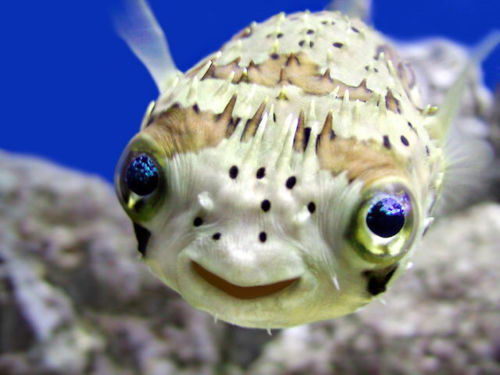Isn’t the name “balloon fish” sound funny? Yes indeed. Even though it has a balloon in its name but it doesn’t mean that it looks like a balloon all the time. Having big and protruded eyes, the fish has an angular topmost section.
Typically, the scales or big spines lie down efficiently on its body. There are very nice fins particularly at the end of this creature. With the whitish shade on its outer shell as well as murky spots sprinkled over its body, balloon fish looks magnificent with its speckled appearance.
A very strong ring-shaped outer skin with a plane face and forward-pointing eyes makes it a perfect hunter during the night and also eludes the upcoming danger. Let’s read more about balloon fish facts for kids.
Balloon Fish Facts For Kids
- The size of balloon fish can stretch up to 50 centimeters though the average size of this fish ranges from 20 cm to 30 cm.
- This fish doesn’t try to plunge over 100 meters deep within the water.
- It is a night-time or nocturnal predator that likes to stay out of sight during the daylight hours.
- When the enemy approaches balloon fish and the attack is imminent, it responds with a magnificent armor and fills its stomach with water. This process continues until the stomach bulges and the spines stand vertical. That is why it is known as balloon fish because it turns itself into a balloon when it is scared.

There are 19 different species of porcupine fish, a class under which balloon fish falls.
- The entire body structure is imbued with coffee color spots while the unique tan coloring around the eyes is the hallmark of balloon fish.
- The eggs of balloon fish move smoothly over the water surface at almost 96 hours before young ones are produced.
- This type of fish goes swimming rather sluggishly.
- The adult balloon fish prefers to stay alone while some young ones usually come together in groups.
- Once in a while, it varies the shade of its body when feeling tension.
- Since they are nocturnal species, so you’ll not spot them in open water during the day rather they confine themselves inside caverns and also ledges to seek shelter.
- They have big eyes that allow them to lurk for prey in the dusk.
- According to experts, the tiger shark stalks balloon fish more often which seems to be the single killer of this fish.
Distribution and Habitat
- Balloon fish fancies living in shallow water and resides mainly in the rocky seabeds, mangroves, sea grass beds and coral reefs of the Atlantic and Pacific Oceans. In the former (Atlantic Ocean), the species of balloon fish extends toward humid regions of West Brazil from Bahamas while in the latter (Pacific), the animal flourishes in large number within various land masses.
- The population of balloon fish sprawls across South California, Caribbean seawaters, Florida and islands including Galapagos, Easter and Equatorial islands while countries like Australia, Canada, Mexico and Japan are home to such species.
- Although they do not like staying deep inside water but some have also seen them at two hundred meters deep inside water.
Feeding Ecology and Diet
The happy menu of balloon fish includes hermit crabs (mostly hermit crabs), snails, coral polyps, sea urchins, mollusks.






Leave a Reply